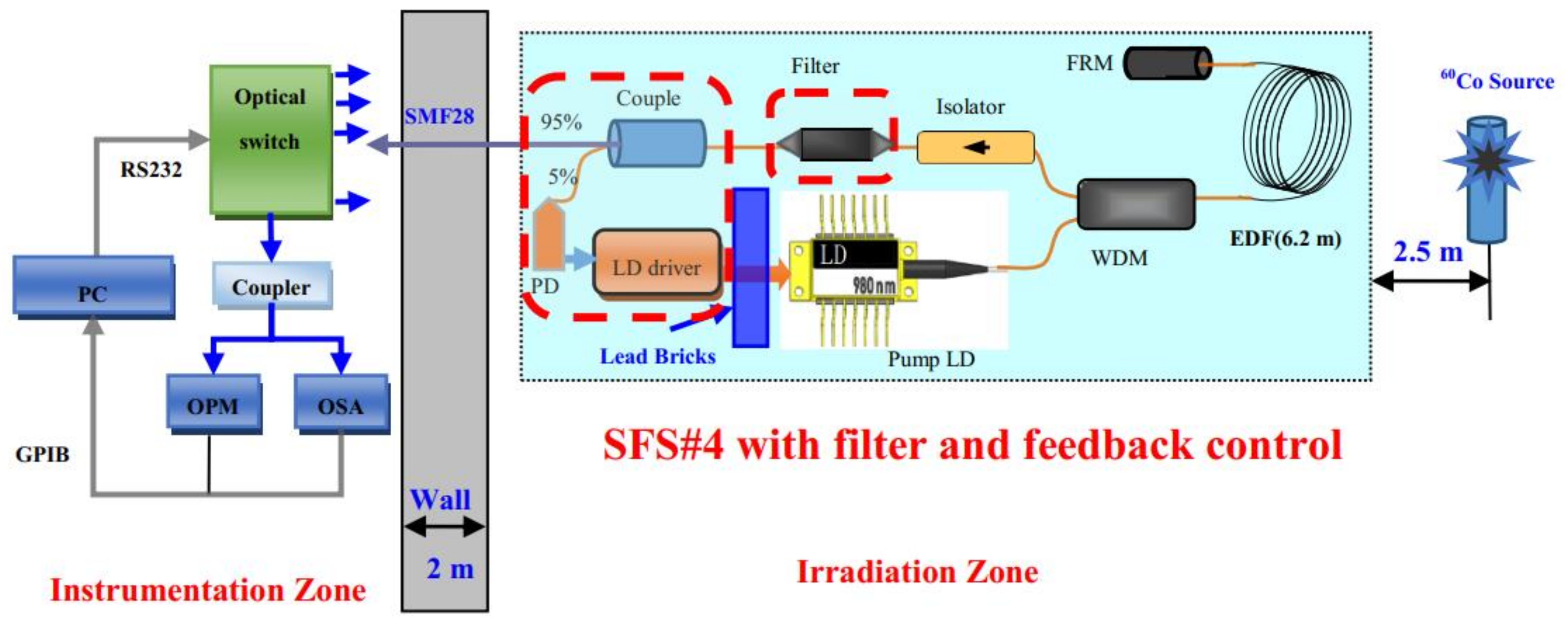Radiation-Resistant Er3+-Doped Superfluorescent Fiber Sources
Abstract
:1. Introduction
2. Pre-Experiments Investigated
2.1. Radiation Experimental Setup
2.2. Tested Er3+-Doped Superfluorescent Fiber Sources
2.3. Influence of Gamma Radiation on SFS Output
3. Improvement of Radiation Resistance by Filtering Technology
3.1. Filter Design
3.2. Calculation of the Spectrum and Mean Wavelength of the Trimming SFS
4. Experimental Results and Discussions
5. Conclusions
Author Contributions
Funding
Acknowledgments
Conflicts of Interest
References
- Wysocki, P.F.; Digonnet, M.J.F.; Kim, B.Y.; Shaw, H.J. Characteristics of erbium-doped superfluorescentfiber sources for interferometric sensor applications. J. Lightw. Technol. 1994, 12, 550–567. [Google Scholar] [CrossRef]
- Wang, W.; Wang, X.F.; Xia, J.L. The influence of Er-doped fiber source under irradiation on fiber optic gyro. Opt. Fiber Technol. 2012, 18, 39–43. [Google Scholar] [CrossRef]
- Yang, Y.H.; Su, X.X.; Yang, W. Radiation-induced attenuation self-compensating effect in super-fluorescent fiber source. Chin. Phys. B 2014, 23, 092413. [Google Scholar] [CrossRef]
- Yang, Y.H.; Suo, X.X.; Yang, M.W.; Shi, X.W.; Jin, W. Radiation-resistance technology for broadband fiber-optic source. In Proceedings of the 21st International Conference on Optical Fiber Sensors 2011, Ottawa, Canada, 15–19 May 2011. [Google Scholar]
- Ting, Y.C.; Wang, H.; Lu, T.Y.; Lin, C.J.; Liaw, S.K.; Liu, R.Y.; Shin, C.S. Ultra low thermal coefficient broadband super-fluorescent fiber source with radiation insensitivity characteristic. In Proceedings of the 2017 International Workshop on Fiber Optics in Access Network (FOAN), Munich, Germany, 6–8 November 2017. [Google Scholar]
- Ang, D.; Timothy, L.S.; Liu, R.Y. Radiation Insensitive Fiber Light Source for Interferometric Fiber Optic Gyroscopes. U.S. Patent 6744966, 1 June 2004. [Google Scholar]
- Peng, T.S.; Wang, L.A.; Liu, R.Y. A radiation-tolerant superfluorescent fiber source in double-pass backward configuration by using reflectivity-tuning method. IEEE Photonic Technol. Lett. 2011, 23, 1460–1462. [Google Scholar] [CrossRef]
- Peng, T.S.; Huang, Y.W.; Wang, L.A.; Liu, R.Y.; Chou, F.I. Photo-annealing effects on gamma radiation induced attenuation in Erbium doped fibers and the sources using 532-nm and 976-nm lasers. IEEE Trans. Nucl. Sci. 2010, 57, 2327–2331. [Google Scholar] [CrossRef]
- Peng, T.S.; Wang, L.A. Radiation-tolerant superfluorescent fiber sources for high-performance fiber-optic gyroscopes working under gamma irradiation higher than 200 krad. IEEE Photonic Technol. Lett. 2012, 24, 1340–1342. [Google Scholar] [CrossRef]
- Liu, R.Y. Interferometric Fiber Optic Gyroscope (IFOG) Using Modulation Technique for Real-Time Calibration of Wavelength Reference under Harsh Environment. E.P. Patent 1780506A2, 5 February 2007. [Google Scholar]
- Liu, C.X.; Zhang, L.; Wu, X.; Ruan, S.C. Gamma radiation effects on erbium-doped fiber in superfluorescent fiber source. Opt. Fiber Technol. 2013, 19, 456–460. [Google Scholar] [CrossRef]
- Liu, C.X.; Zhu, J.H.; Wu, X.; Zhang, L.; Ruan, S.C. Improvement of radiation resistance of Er-doped photonic crystal fiber source by spectrum trimming. In Proceedings of the Fifth Asia-Pacific Optical Sensors Conference, Jeju, Korea, 20–22 May 2015. [Google Scholar]
- Wu, X.; Liu, C.X.; Wu, D.; Li, M.; Ruan, S.C. Radiation resistance of an Er/Ce codoped superfluorescent source of conventional fiber and photonic crystal fiber. Opt. Eng. 2017, 56, 126109. [Google Scholar] [CrossRef]
- Xing, R.X.; Sheng, Y.B.; Liu, Z.J.; Li, H.Q.; Jiang, Z.W.; Peng, J.G.; Yang, L.Y.; Li, J.Y.; Dai, N.L. Investigation on radiation resistance of Er/Ce co-doped silicate glasses under 5 kGy gamma-ray irradiation. Opt. Mater. Express 2012, 2, 1329–1335. [Google Scholar] [CrossRef]
- Brichard, B.; Tomashuk, A.L.; Ooms, H.; Bogatyrjov, V.A.; Klyamkin, S.N.; Fernandez, A.F.; Berghmans, F.; Decréton, M. Radiation assessment of hydrogen-loaded aluminium-coated pure silica core fibres for ITER plasma diagnostic applications. Fusion Eng. Des. 2007, 82, 2451–2455. [Google Scholar] [CrossRef]
- Thomas, J.; Myara, M.; Troussellier, L.; Burov, E.; Pastouret, A.; Boivin, D.; Melin, G.; Gilard, O.; Sotom, M.; Signoret, P. Radiation-resistant erbium-doped-nanoparticles optical fiber for space applications. Opt. Express. 2012, 20, 2435–2444. [Google Scholar] [CrossRef] [PubMed]
- Girard, S.; Ouerdane, Y.; Bouazaoui, M.; Marcandella, C.; Boukenter, A.; Bigot, L.; Kudlinski, A. Transient radiation-induced effects on solid core microstructured optical fibers. Opt. Express 2011, 19, 21760–21767. [Google Scholar] [CrossRef] [PubMed]
- Likhachev, M.E.; Bubnov, M.M.; Zotov, K.V.; Tomashuk, A.L.; Lipatov, D.S.; Yashkov, M.V.; Guryanov, A.N. Radiation resistance of Er-doped silica fibers: effect of host glass composition. J. Lightw. Technol. 2013, 31, 749–755. [Google Scholar] [CrossRef]
- Pavel, F.K.; Alexander, L.T.; Mikhail, Y.S.; Alexey, N.A.; Konstantin, N.N.; Alexey, N.G.; Evgeny, M.D. Radiation-Induced Attenuation in Silica Optical Fibers Fabricated in High O2 Excess Conditions. J. Lightw. Technol. 2015, 33, 1788–1793. [Google Scholar]
- Hui, F.; Tianjin, M.L.; Ma, L.; Zuo, W.; Zhang, S.; Zhang, X.M. Investigation on near Gaussian-shaped spectrum erbium-doped fiber source which applied to the fiber optic gyroscope. In Proceedings of the 2017 24th Saint Petersburg International Conference on Integrated Navigation Systems (ICINS), Saint Petersburg, Russia, 29–31 May 2017. [Google Scholar]











| SFS | Configuration | EDF Length (m) | Pump LD Power (mW) | Output Power (mW) |
|---|---|---|---|---|
| SFS#1 | DFB | 6.20 | 70.00 | 14.96 |
| SFS#2 | DFB | 8.30 | 70.00 | 15.90 |
| SFS#3 | DFB | 17.20 | 71.00 | 18.59 |
| SFS | Mean Wavelength Shift (ppm) | Power Change (%) |
|---|---|---|
| SFS#1 | 6.489 | 0.402 |
| SFS#2 | 11.627 | 0.472 |
| SFS#3 | 11.539 | 0.658 |
© 2018 by the authors. Licensee MDPI, Basel, Switzerland. This article is an open access article distributed under the terms and conditions of the Creative Commons Attribution (CC BY) license (http://creativecommons.org/licenses/by/4.0/).
Share and Cite
Liu, C.; Wu, X.; Zhu, J.; He, N.; Li, Z.; Zhang, G.; Zhang, L.; Ruan, S. Radiation-Resistant Er3+-Doped Superfluorescent Fiber Sources. Sensors 2018, 18, 2236. https://doi.org/10.3390/s18072236
Liu C, Wu X, Zhu J, He N, Li Z, Zhang G, Zhang L, Ruan S. Radiation-Resistant Er3+-Doped Superfluorescent Fiber Sources. Sensors. 2018; 18(7):2236. https://doi.org/10.3390/s18072236
Chicago/Turabian StyleLiu, Chengxiang, Xu Wu, Jianhui Zhu, Nie He, Zhuoyan Li, Gongshen Zhang, Li Zhang, and Shuangchen Ruan. 2018. "Radiation-Resistant Er3+-Doped Superfluorescent Fiber Sources" Sensors 18, no. 7: 2236. https://doi.org/10.3390/s18072236
APA StyleLiu, C., Wu, X., Zhu, J., He, N., Li, Z., Zhang, G., Zhang, L., & Ruan, S. (2018). Radiation-Resistant Er3+-Doped Superfluorescent Fiber Sources. Sensors, 18(7), 2236. https://doi.org/10.3390/s18072236





